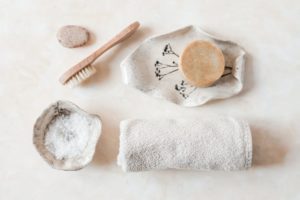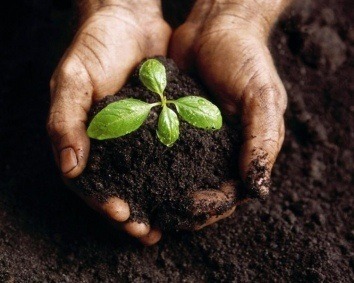 Bokashi composting is a way to turn table scraps and kitchen wastes into a rich garden soil. The Bokashi method does not produce bad smells or attract pests, and unlike traditional composting, it uses meat and dairy products in addition to plant material. It is far faster than traditional composting piles, completing in about five weeks rather than many months. Bokashi composting is an ideal method for those who love to grow food without using chemicals, and who enjoy recycling useful things. Bokashi follows centuries-old traditions and adds modern science. It is convenient, simple, and it helps a garden grow with spectacular results.
Bokashi composting is a way to turn table scraps and kitchen wastes into a rich garden soil. The Bokashi method does not produce bad smells or attract pests, and unlike traditional composting, it uses meat and dairy products in addition to plant material. It is far faster than traditional composting piles, completing in about five weeks rather than many months. Bokashi composting is an ideal method for those who love to grow food without using chemicals, and who enjoy recycling useful things. Bokashi follows centuries-old traditions and adds modern science. It is convenient, simple, and it helps a garden grow with spectacular results.
Bokashi composting is essentially a two-phase process of fermentation followed by decomposition. The fermentation process takes about two weeks, and the complete process takes four to five weeks. One can do the first phase indoors or outside, which is ideal for everyone whether homeowners and apartment dwellers alike. The simple set-up can be convenient to kitchen areas converting kitchen and table food scraps into a valuable source of compost. The second phase requires an outdoor area or a worm bin.
Bokashi: Composting The Japanese Way
Bokashi composting is different from other methods; it includes a broader range of usable wastes, works indoors or outside, has a shorter time for processing, and it supports most other methods of decomposition. One can use dairy scraps and leftovers, and cooked and uncooked meats; other methods exclude these items. Because the Bokashi method does not produce strong odors, it works well indoors. The container can sit in a convenient location like a kitchen. The processing time is ten to fourteen days to produce pre-compost. The additional cure period is a week to ten days. Thus, the scraps can provide nutrients to support plants in as little as four weeks. To complete the decomposition, the pre-compost can go into the ground, an existing compost pile, or in a worm bin. In these ways, Bokashi integrates with the other widely used methods of composting.
What is Bokashi Composting?
Bokashi is an anaerobic (no air) process in which microbes and bacteria ferment foods and prepare them for decomposition in soils. The process resembles pickling or fermenting grapes into wine. Because the microbes work without air, they do not produce bad odors like sulfur dioxide, the well-known rotten egg smell. Bokashi requires a covered and sealed container, some EM (effective microorganisms) medium, food scraps, and darkness. The microbes at work in Bokashi produce odorless amino acids and small amounts of alcohol rather than ammonia, hydrogen sulfides, or sulfur dioxide.
History of Bokashi Composting
 For many centuries, farmers in Korea and Japan maintained the practice of adding food scraps to local soils and fermenting them. The rich local soils contained microbes that broke down the scraps into fermented substances. It was called Bokashi, which some have roughly translated into English as the phrase “fermented organic matter”. After some time had passed, they mixed the scraps and soil into planting areas as a long-term source of nutrients. The practice combined the habits of recycling and not wasting food with the desire to grow food naturally. These principles continue today as growers mix microbe rich soil and food scraps and other wastes to blend into compost.
For many centuries, farmers in Korea and Japan maintained the practice of adding food scraps to local soils and fermenting them. The rich local soils contained microbes that broke down the scraps into fermented substances. It was called Bokashi, which some have roughly translated into English as the phrase “fermented organic matter”. After some time had passed, they mixed the scraps and soil into planting areas as a long-term source of nutrients. The practice combined the habits of recycling and not wasting food with the desire to grow food naturally. These principles continue today as growers mix microbe rich soil and food scraps and other wastes to blend into compost.
Development of Bokashi Composting
In the early 1980’s, an Okinawa-based university researcher named Teruo Higa isolated some strains of bacteria and microbes that caused the fermentation effects in the traditional practices. Mr. Higa, a Professor at the Ryukyus University, developed a commercial process for Bokashi composting. His method offered a prepared mix to break down scraps into fermented organic matter. The manufacture and promotion of commercial Bokashi products began in about 1982 with the introduction of EM enhanced bran Bokashi mix. This line of production followed the research and development work of Professor Higa. His contributions included identifying the bacteria and microbe strains that produced the fermentation effects. It was effective on a broad range of foods including cooked or raw meat, dairy, vegetables, fruits, grains, bones, eggs and egg shells, cheese, coffee grounds, tea leaves and tea bags. Leftover meals, picked-over plates of food, trimmed meats or poultry, fish, and fruit and vegetable peels are among the everyday items that can go into the composting bucket.
Bokashi grew into a popular form of organic gardening in Asia and then in Europe; Bokashi has spread slowly in the United States. There has been a particular acceleration in the past ten years as businesses, online advocates, and suppliers have gained followings. The attraction for many promoters is socially conscious; there is an enormous amount of food wastes in the United States, and the costs to the public in landfill alone are staggering. The EPA notes that about 14 percent of the annual landfill and incinerator mass is now food wastes. Methane, a dangerous greenhouse gas produced by decomposing food wastes, is a major concern for global warming.
Benefits of Bokashi Composting
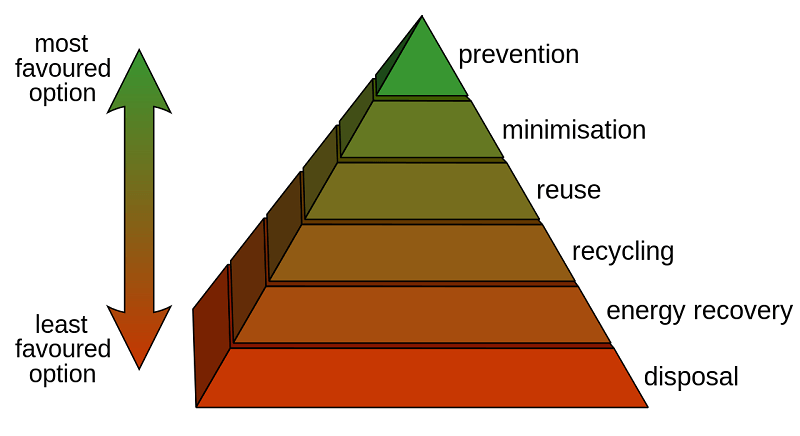 For those who value natural, organic gardening, nutrient rich soil is the solid foundation for building an abundant food source. Compost is the key to productive, organic fertilizer. It is the black gold that enriches the soil to support the widest range of crops. Plants grow faster, fuller, and more abundantly in composted soil. Bokashi is a natural and organic approach to improving soil conditions. The process does not involve adding chemicals to the ground that ultimately affect the air and water. The items below describe particular benefits of Bokashi composting.
For those who value natural, organic gardening, nutrient rich soil is the solid foundation for building an abundant food source. Compost is the key to productive, organic fertilizer. It is the black gold that enriches the soil to support the widest range of crops. Plants grow faster, fuller, and more abundantly in composted soil. Bokashi is a natural and organic approach to improving soil conditions. The process does not involve adding chemicals to the ground that ultimately affect the air and water. The items below describe particular benefits of Bokashi composting.
Advantages of Bokashi Composting
- It has low odor and can be used nearly anywhere indoors or outside.
- It uses table and kitchen scraps rather than putting them in the trash (landfill) or disposal (waste water treatment).
- It avoids wasting nutrient-rich recyclable food.
- Meats and dairy, excluded from most composting, can be used in Bokashi
- It is quick; the fermentation phase goes from wastes to the soil in two weeks.
- The complete composting process can take as little as four weeks.
The Conscience of the World
This is still a world in which people go hungry and sometimes suffer from a lack of food. According to the World Bank, more than 1.0 billion people live on less than $1.25 per day, and 2.2 Billion people live on $2 or less per day. The United Nations estimates that globally, the threat of starvation and chronic malnutrition affects more than 800 million people. In the United States, the Environmental Protection Agency estimates that Americans discard approximately 35 million tons of food. This level of waste represents a 20 percent increase over the year 2000 total and a 50 percent increase above the 1990 figure. By historical contrast, it was nearly three times the 12.2 million tons discarded in 1960.
Given these facts, it is especially bothersome for some that there is massive food waste in places like the United States while two billion people live the edge of devastating hunger. The two things seem unrelated, but many people consider how small the global economy has made the world. For example, the prices paid for food in the US affects its availability everywhere else. For socially conscious citizens of the world, gardeners and growers, wasting food is never a good idea, and especially not in a world in which billions of people face chronic hunger.
Buy or Build the Bokashi Bucket
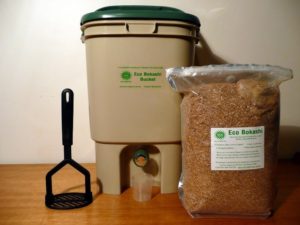 Growers can buy Bokashi buckets with easy drain valves or spigots built in. We’ve included a couple options at the end of this article worth checking out. There are a number of online sellers and a growing number of local providers that offer them. Some may seem pricey given that they are little more than a plastic container, however, the ease of draining from a valve or spigot is worth consideration. Without the valve, one must lift the top bucket and pour out the liquid.
Growers can buy Bokashi buckets with easy drain valves or spigots built in. We’ve included a couple options at the end of this article worth checking out. There are a number of online sellers and a growing number of local providers that offer them. Some may seem pricey given that they are little more than a plastic container, however, the ease of draining from a valve or spigot is worth consideration. Without the valve, one must lift the top bucket and pour out the liquid.
Building a bucket is simple and inexpensive. One can use two five-gallon containers of the same size, and a lid. One bucket will rest on the other. To prepare them, drill many small holes in the bottom of one bucket and place it inside the other. The top bucket will hold the scraps and Bokashi mix, and the holes will permit drainage of any liquid in the foods into the space between the buckets. As an alternative to keeping the leachate or Bokashi Tea, one can simply line the bottom of the containers with an absorbent material like sawdust, cardboard or newspaper. The essential point is to keep the liquid away from the fermenting scraps. Moisture will inhibit or slow down the fermentation process.
Commercial Mix and Kits
Growers can purchase the EM mix and complete composting kits from online and local sellers. This is an easy option and avoids the time required to make the mix and to fashion a container.
- Starting the Process
If purchasing the Bokashi mix, the purchase decision will probably involve determining the best quantity. The mix stores and keeps well in dry conditions. Manufacturers usually suggest a shelf life of four to five years. Purchasing the mix provides an instant start to the process. Manufacturers offer complete kits that provide containers for making the fermented pre-compost.
- The Bokashi Container
The container is important it must be sealable and have a place for the liquid to run–off from the scraps and Bokashi mix. Most commercial Bokashi containers have an inner reservoir built-in with a spigot to remove the leachate. One can make a container from two five-gallon paint buckets and a lid. Drill many holes in the bottle of one and set it inside the other so that there is a space for liquids between the two buckets. During the processing, one will have to lift the top bucket and pour off the leachate. Some creative, air-tight way of adding a spigot to the lower bucket would probably save a lot of heavy lifting.
- Pre-Compost Fermented Organic Matter
After gathering scraps from the table, sink and kitchen cutting boards and adding Bokashi mix to cover them. The airtight container will be filled and ready to complete its mission of making fermented organic matter. It merely takes time and emptying any leached liquid for about ten days. After this time, the pre-compost is ready to complete the process of becoming rich earth. One must decide the completion method.- Troubleshooting the Bucket Fermentation Process
- One can use the Bokashi mix generously. Too little can leave an odor problem. If one detects odors, then add more mix.
- Keep air out of the bucket and use a tight-fitting lid.
- Press air out of the scraps by pressing the mix down
- An inner lid is good or this. An old pot cover or a plate with a knob added will do well to cover the scraps and press air out after each addition.
- Troubleshooting the Bucket Fermentation Process
- Completing Composting
There are three primary ways of completing composting. One can add the pre-compost to an active compost pile, bury it in the ground, or feed it to a worm bed, or vermicompost bin.- Compost pile method: the pre-compost is highly acidic, and many plants have roots systems that burn from contact with acidic soils. The compost pile method must cure for one week to ten days before use as a planting area. Once cured, the composted Bokashi provides a slow release form of nutrients as worms, microbes, and insects digest the decomposing food scraps
- Vermicompost bin: An existing worm bin is a great way to finish the composting process. In this way, Bokashi Composting speeds up and improves existing systems. The advantages of using a wide range of scrap food remains, and worm castings add nitrogen to the compost.
- Bury in the ground: The in-ground burial method is an easy on to do; one must use about 8 inches of dirt to cover the Bokashi compost so as not to attract pests. The fresh pre-compost is acidic, and it cures in about a week to ten days. After ten days, one can plant any crop without fear of hurting the tender roots.Homemade Bokashi Mix
Making Bokashi Mix
A brief summary of making the Bokashi mix is as follows. Start with something to capture the right bacteria and microbes. Bokashi uses three strains: phototropic-purple non-sulfur bacteria, bacteria that make lactic acid, and yeast. These, or bacteria like them, are common. They are the active organisms in yogurt and fermented hay produced worldwide as animal feed. These microbes make an odor associated with fermentation, but it is not foul like those of other decomposition processes.
Making the Serum. Mix vigorously one cup of rice in two cups of water, drain the cloudy white liquid. Place the white liquid in a container leaving the upper half of the space empty. Cover the container loosely so that air flows in and out easily. Set aside in a dark space for five-seven days. The liquid should have a slight sour smell. Strain any particles and put the liquid in a large container. Measure the amount of liquid as one part, and add ten (10) parts of skim or another type of milk. Cover lightly so gasses can escape and let sit for 14 days to ferment. After 14 days, strain the solids and the remainder is the Bokashi serum.
The Homemade Bokashi Mix. Mix the serum into the mixture as follows: one part serum, and one part molasses, to six parts water. This blend is the liquid for soaking the bran, sawdust, or newspaper. Using newspaper as the example, one should put some newspaper in a tray and pour the mixture over it, and soak the newspaper thoroughly. Remove the paper and put it into a large plastic zip bag. Let the wet newspaper sit in the bag for 14 days. After14 days, remove the newspaper, separate each sheet and let them dry. Once dry, they are ready for use. They can store on the shelf for up to four years.
Starting the Bucket with Homemade Mix. When using newspaper, place one sheet to cover the bottom of the bucket and begin adding scraps. If using bran or sawdust then start the bucket with a layer of the inoculated bran or sawdust. Repeat the process of scraps covered by a layer of paper, treated sawdust or bran.
Bokashi Tea
The liquid that forms in the bottom of the double is a very useful by-product of Bokashi composting. Called Bokashi Tea, this liquid product of the drying process contains water, sugars, and microbes. It is excellent for sewer drains and pipes because the microbes consume odor causing organic buildups. Regular use of Bokashi Tea will help keep drains running smooth and odor free. The strong liquid can be mixed with a high volume of water to make a liquid organic fertilizer. One should mix in a proportion of one part Tea to 100 parts water for use in gardens or on crops.
Helpful Tips:
- Some frugal users add absorbent material to the bottom of the bucket rather than a drain valve for the leachate. This step can save expenses, and the results seem to be comparable to those that remove the liquid. The liquid has uses as stated above, and those uses are significant such as clearing drains and naturally fertilizing a garden area.
- Cut the scraps into small pieces before adding to the bucket
- Keep the layers of waste thin – one inch or less between layers of Bokashi mix or newspaper. Thin layers promote bacteria activity over all of the food scrap surfaces.
- Limit the air – keep the lid closed and collect scraps and add them all at once to avoid opening the top frequently.
Bokashi Buckets & Composting Kits
As you know, bokashi Composting is a fermentation process that can be a great supplement to regular composting. It can be good to give your garden and soil more than one variety of compost in order for it to have the many nutrients it needs to grow healthy plants. Here we feature some of the simplest Bokashi compost bins for your kitchen, as well as some great Bokashi mixes to get you started.
SCD Probiotics All Seasons Indoor Composter and Bokashi Mix
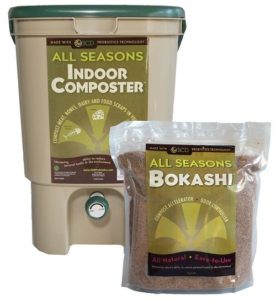 SCD Probiotics has found a perfect way to supplement your composting routine without hassle. The Indoor Composter is a frugal and quick way to get started. Your indoor plants will love the juice that is produced and easily accessed with the built-in drain spout and filtered by the strainer to prevent clogging. The handle will make for easy transport out to your outdoor compost bin when it needs to be emptied. The air tight lid allows for fast fermentation and decomposition. The bokashi mix that is included will cut out a step in the shopping process so that you can get started right away. This small kit will give you a great start.
SCD Probiotics has found a perfect way to supplement your composting routine without hassle. The Indoor Composter is a frugal and quick way to get started. Your indoor plants will love the juice that is produced and easily accessed with the built-in drain spout and filtered by the strainer to prevent clogging. The handle will make for easy transport out to your outdoor compost bin when it needs to be emptied. The air tight lid allows for fast fermentation and decomposition. The bokashi mix that is included will cut out a step in the shopping process so that you can get started right away. This small kit will give you a great start.
- Size: 5 Gallons 12 x 12 x 16
- Weight: 5 lbs.
- Best Features: Strainer
Sunwood Life Bokashi Compost Kit
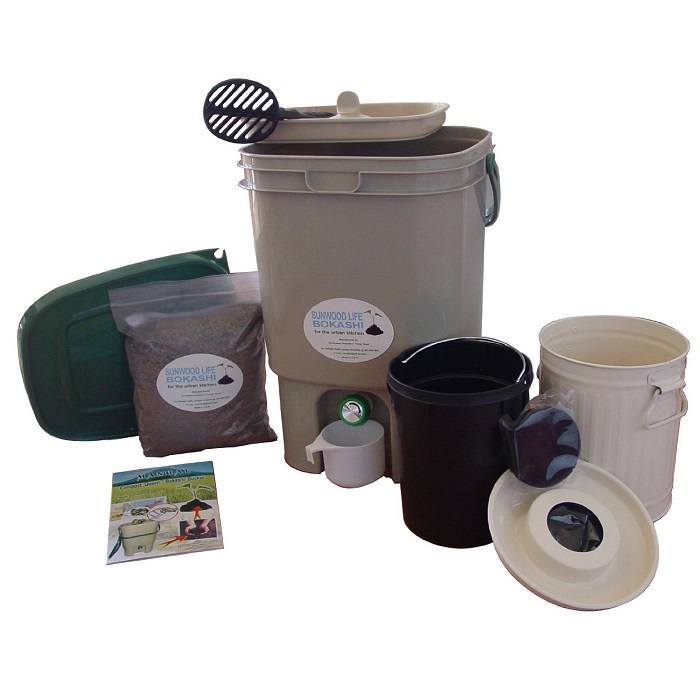 This Bokashi System spells out convenience. It comes with a strainer and spigot that makes collecting the compost tea easy, and if you don’t have room for it near your kitchen: never fear. This set includes a kitchen collector so you can fill it up with compostable goods before taking it to the bin. Being green starts at the source, with the unit being made from recycled plastics. It also includes a 2 pound bag of Bokashi Bran that is effective at getting the fermentation and decomposing process started with no odor! Adding the fermented compost to your bin outdoors from this bin will also help keep away pests and add more nutrients to your humus!
This Bokashi System spells out convenience. It comes with a strainer and spigot that makes collecting the compost tea easy, and if you don’t have room for it near your kitchen: never fear. This set includes a kitchen collector so you can fill it up with compostable goods before taking it to the bin. Being green starts at the source, with the unit being made from recycled plastics. It also includes a 2 pound bag of Bokashi Bran that is effective at getting the fermentation and decomposing process started with no odor! Adding the fermented compost to your bin outdoors from this bin will also help keep away pests and add more nutrients to your humus!
- Size: (Main Unit) 5 Gallon 11.5 x 11.5 x 16.5 (Smaller Kitchen Pail ¾ Gallon)
- Weight: 8 lbs.
- Best Features: Kitchen Collector and Bokashi Bran
For further reading on bokashi composting we suggest checking out Bokashi Composting: Scraps to Soil in Weeks by Adam Footer.

